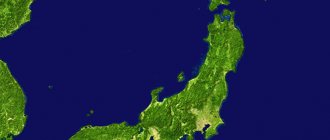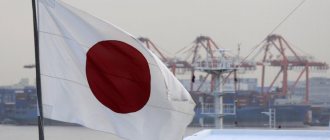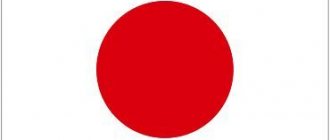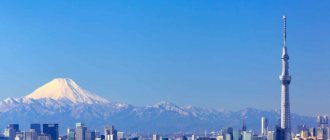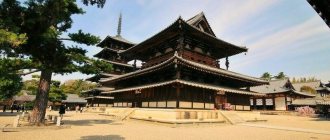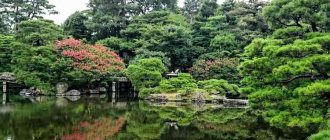This island state, washed by the Pacific Ocean and seas, was isolated for a long time. The geographical location of Japan greatly influenced the economic, political and cultural processes within the country. An interesting fact is that, having opened its borders only in the 19th century, Japan quickly joined global processes and became one of the leading countries.
Where is
Japan is located in the eastern part of Asia. From the southwest, Japan is washed by the East China Sea, which shares it with China. To the west, the Sea of Japan separates Japan and Korea. In the north and northwest, the country borders the Far Eastern region of the Russian Federation. The closest territories are the Kuril Islands and Sakhalin.
On the eastern side, Japan is washed by the Pacific Ocean.
There are several groups of islands belonging to it:
- Nampo,
- Izu,
- Ogasawara,
- Kazan,
- Minamitori et al.
Extreme points
Japan is a state that does not have land borders. The length of its coastline is 29.751 thousand km.
Its extreme points are located in the following places:
- North - Bantejima Island,
- South - Okinotori Atoll,
- Western - Cape Irizaki (Yonaguni Island),
- Eastern - Minamitori Island.
Square
The area of the state is 377 thousand 915 square meters. km, including all the islands belonging to it.
The largest are (area thousand sq. km):
- Honshu (231.1),
- Hokkaido (83.46),
- Kyushu (42.18),
- Shikoku (18.79),
- Okinawa (2.28).
They cover 97% of the country's total area.
Population
As of 2021, the total population is 127.236 thousand people. Not surprisingly, the largest island, Honshu, is also the most densely populated, with a population density of 447 people per square kilometer. The island's population is 103 million people. The capital, Tokyo, is also located here. The next largest island, Hokkaido, has a population of 5.6 million people and a density of 64.49 people. per sq. km. The island of Kyushu shelters 12 million people on its territory, taking into account the area of the island, it is also densely populated, the density is 371. On Shikoku, the density is 220 people. per sq. km.
This shows that the population is distributed unequally throughout the country, depending on the topography of the island, distance from the capital and the presence of large cities. The country has a high level of urbanization. In this regard, the average population density is 334 people.
Population.
In terms of population (more than 135 million people), Japan is one of the top ten countries in the world. However, over the past decade, the nature of the natural population movement has changed dramatically. Japan became the first Asian state to move from the second to the first type of reproduction. According to forecasts of Japanese demographers, the population will stabilize by 2010 at the level of 130 million people. A major problem for Japan has been the rapid increase in the proportion of people over 65 years of age. Life expectancy in this country is the highest in the world (76 years for men, 82 years for women). The population of Japan is characterized by national homogeneity (more than 95% are Japanese). Of other nationalities, the number of living Koreans and Chinese is significant.
The Japanese language is very specific and does not belong to any language family. The Japanese writing system is also very complex, using both hieroglyphs and the dictionary alphabet.
The population is distributed unevenly throughout the territory. With a high average density (more than 330 million people per 1 km2), some areas according to this indicator are the most densely populated areas in the world (these are coastal areas of the Pacific coast, where 2/3 of the country's population lives).
Almost 4/5 of Japan's population are urban residents. 11 cities have a population of over 1 million people. The largest urban agglomeration is Kehin (Tokyo - Yokohama), where more than 25 million people are concentrated in 150 settlements. Together with the two other largest agglomerations Hanshin (Osako - Kobe - Quito) and Chuke (Nagoya, etc.), as well as with the cities located between them, the Keihin agglomeration merges into a single system - the Tokyo metropolis (Tokaido). Its total population is more than 60 million people.
The metropolis of Tokaido stretches along the coast for 600 - 700 km. The average population density within its borders is 800 – 1000 people. per 1 km2. The proximity of the sea and the winding coastline create favorable conditions for the development of maritime transport and the construction of ports.
Peripheral centers such as Sapporo and Sendai are also growing rapidly. And outside the metropolis, another agglomeration was formed - Chinakyushu-Fukuoka (in the north of Kyushu island).
National composition
Due to the policy of restricting migration, Japan is a single-national country. This suggests that 99% of the population is Japanese.
Despite this, about 600 thousand Koreans live on the islands, many of whom were born in Japan. There is also a significant Chinese group present. Separately, small groups of the following nationalities are distinguished: Ryukians, Ainu, Eta.
History of development
Now Japan is one of the most developed countries in the world. But back in the early 19th century, it was a fragmented agrarian periphery, closed from external influences.
The situation changed in the mid-18th century. By this time, many Asian powers, primarily China and Korea, were already building economic relations with Western countries. Gradually, goods from Western powers begin to penetrate Japanese markets, often under pressure from the navy, since they had long been resisted. This led to a worsening of the already deplorable internal economic situation. The de facto ruler of the country - the feudal warlord, the Tokugawa shogun - was forced to raise taxes, which led to discontent among citizens. All this was the reason for the coup, called in history the Meiji Restoration. Emperor Mutsuhito abolished the shogunate and became sole ruler, bringing back the monarchy.
The Meiji (Enlightened Rule) era was a turning point for Japan. At this time, the borders are opening. Japan begins to adopt the knowledge and technology of the West, forming an army and navy according to the German and British model. Trade with Europe and the USA is developing. A number of internal reforms are being carried out to improve the situation in the country. By the time of the emperor's death in 1912, the Land of the Rising Sun had become a highly developed world power.
The period between the world wars had a very negative impact on the internal situation of the country:
- The collapse of leadership after the death of Meiji and the rise to power of the military.
- The oppression of the domestic economy by the Western powers.
- The position of the aggressor in World War II, its consequences: destruction, reduction of territory, loss of military power and independence.
This moved the country away from leading world trends for some time, which subsequently played a positive role. Without participating in the military clashes of the Cold War, without spending huge amounts of money on the arms race, Japan directed all funds to restore the state, economy and social status of its citizens. This led to record economic growth from the 1950s to the 1970s, called the Japanese Economic Miracle.
The phenomenon of this country is that despite the opening of borders and the active penetration of Western civilization, Japan managed to preserve its traditions and remain original. The sharp contrast between modern technology and the traditional way of life still interests and fascinates both scientists and politicians, as well as ordinary citizens.
Economic and geographical characteristics of Japan
Japan is an Asian island archipelago state. Most of the country's land is located on the islands of Hokkaido, Honshu, Kyushu and Shikoku. In total, Japan consists of 6852 islands surrounded by the waters of the Pacific Ocean. The bulk of the population lives on the coastal plains. The total area of Japan is 378,000 sq. km.
Neighboring countries: Russia, China, North Korea, South Korea, Taiwan - are very different in economic potential and political system. Japan is an active member of the UN, the Organization for Economic Cooperation and Development, and the Asia-Pacific Economic Cooperation.
In order to analyze the economic and geographical situation, it is necessary to consider such indicators as population and economy, nature and resources, as well as interaction with other states.
Population of Japan : 127 million people. About 80% of people live in cities. In Japan, 11 cities have millionaires. The capital of Japan is the world's largest urban agglomeration - Tokyo, with a population of 30 million people. In addition to Tokyo, Kyoto, Hiroshima, Nagoya, Kobe, Osaka and Yokohama are considered major cities.
Japan is predominantly a one-ethnic country. The Japanese make up 99% of the population and rarely allow foreigners into their society. Accordingly, most citizens speak Japanese. In Japan, middle-aged and older people predominate. This is due to the fact that a very small percentage of births is recorded among the residents. Therefore, there is a low population growth rate - only 2 people per thousand per year.
Religion in Japan is represented mainly by Buddhism and Shintoism, and is characterized by so-called religious syncretism - the practice of several religions at once. This leads to a mixture of different religious practices. Thus, adults and children celebrate Shinto holidays, schoolchildren pray before exams, young couples arrange wedding ceremonies in a Christian church, funerals take place in Buddhist temples.
Nature and resources are an important indicator of the economic and geographical position of Japan. One of the main factors in the development of the country's economy is the natural resource base, determined by its geographical location. The geological basis is underwater mountain ranges. Therefore, approximately 80% of Japan's surface is located on mountains and hills with pronounced relief up to 1700 meters in height. There are almost two hundred volcanoes in Japan. 90 of them are active, among them the highest point of the archipelago - Mount Fuji, whose height is 3776 meters. Natural phenomena such as tsunamis and earthquakes have a tangible impact on the country’s economy.
A distinctive feature of the Land of the Rising Sun is that it occupies a high position in the world economy due not to the presence of rich natural resources, but to their absence. Japan is not rich in mineral resources, so the country is the largest importer of raw materials. It is forced to import 99% of all the ores it uses, 96% of the combustible minerals and 70% of the timber it uses.
The country has many rivers that are sources of irrigation and hydropower, but are not suitable for navigation. Many inland water sources have a positive impact on production. After the war, the environmental situation in Japan worsened. Legislative innovations for the protection and protection of the environment are reducing the level of pollution.
To analyze the economic and geographical position of Japan, it is necessary to pay attention to some aspects of its national economy. Although Japan has few natural resources of its own, and the government has to import raw materials for a large number of industries, the Land of the Rising Sun manages to occupy a leading position among other countries in the production of products of various industries. Most production is concentrated within the Pacific industrial belt. Thus, Japan leads in terms of steel production. It owns 23% of the world ferrous metallurgy market. The state occupies a leading position in shipbuilding, specializing in the production of large-tonnage tankers and dry cargo ships. The main centers of ship repair and shipbuilding are large ports (Yokohama, Nagasaki, Kobe). Japan also leads in car production (13 million per year). Main production centers: Toyota, Yokohama, Hiroshima. Mechanical engineering provides 40% of industrial products. The main sub-sectors of production in Japan are electronics and electrical engineering, transport engineering and the radio industry.
Agriculture is an important sector of the Japanese economy, although it contributes about 2% of GNP. This industry focuses on the food sector, providing 70% of food needs. Due to the predominant position of seafood in the diet of residents, fishing is carried out in many areas of the sea. At the same time, Japan has more than 3,000 ports and the largest fishing fleet (more than 400,000 vessels).
The economic position of Japan in the world allows us to assess the economic and geographical position of the country. Japan leads in terms of GDP per capita of $24,400. At the end of the 20th century, Japan had the highest economic growth rate of 9.8% per year. Now Japan is demonstrating a post-industrial stage of development, while industry is quite developed, but efforts are most concentrated on the non-manufacturing sector. Banking, trade, telecommunications, insurance, transport, real estate and construction play a huge role in its economy. The country has significant manufacturing capacity and is home to major manufacturers of machinery, electronics, ships, machine tools, steel, textiles, food products and chemicals. Famous corporations are located in Japan: Toyota, Honda, Mitsubishi, Canon, Nintendo, Sony, NTT DoCoMo, Takeda Pharmaceutical, Nippon Steel and others. Japan is also home to several of the largest banks and the Tokyo Stock Exchange, which ranks 2nd in market capitalization. In 2006, 326 Japanese companies were included in the Forbes 2000 list.
According to statistics, Japan is in 4th place in exports and 6th in imports. export partners for Japan are China, the USA, South Korea, Hong Kong, Taiwan, and the import partners are China, the USA, South Korea, Saudi Arabia, the UAE, Australia and Indonesia. Exports are dominated by motor vehicles, chemicals and electronics. Imported products include machinery and equipment, food products, textiles, industrial raw materials, fuel, and chemicals. However, import costs are many times less than what Japan receives from its exports. Japan sells cars, ships, machine tools, equipment and many other goods all over the world. The country also introduces high technologies and invests capital in the industry of neighboring countries. A number of reforms have been carried out that encourage market competition, which has led to an increase in foreign investment, thanks to which Japan has a positive trade balance, as well as the image of one of the most economically developed countries.
An analysis of the economic and geographical position of Japan shows what position this country has on the world stage. The impressive economic and geographical characteristics of Japan are determined by its economic position. This archipelago country has no land neighbors, which definitely has a significant impact on the development of the economy and production. The country's political position corresponds to its role in the world economy. Japan is an influential member of the G8, the UN, ASEAN and the East Asia Summit and other organizations that determine the economic development of the world community for decades to come.
Japan is an amazing country, different in many ways from Russia and Europe, so traveling there requires careful preparation. To make your trip as positive as possible, we have prepared for you a master class on traveling to Japan. Go through it right now and be fully prepared!
We recommend:
Economics and politics
Japan's form of government is a constitutional monarchy. The highest authority is the bicameral parliament, the State Council, consisting of the House of Representatives (lower) and the House of Councilors (upper).
It is the parliament that is:
- An exponent of the will of the people.
- Bearer of state sovereignty.
- The only legislative body with the power to make laws.
The governing body of the executive branch is the Cabinet of Ministers, headed by the Prime Minister. He is the de facto head of state. The cabinet governs the state in relation to the budget and laws approved by parliament.
The Emperor is a symbol of the country and the unity of the nation. He carries out all political actions with the consent of the Cabinet of Ministers.
Its functions mainly include:
- performing ceremonies,
- reception of foreign guests,
- publication of legislative actions of parliament,
- awarding awards, etc.
A distinctive feature of the Japanese economy is active government intervention. This made it possible to quickly recover in the 50s-60s and survive the oil crisis of the 70s. Currently, overcoming the crisis in the country's economy is seen in liberal reforms.
First of all this:
- Privatization of the public sector.
- Weakening regulation of financial markets.
- Reform of the budgetary and banking sectors.
- Easing currency regulation.
Scarce natural and mineral resources, minerals and the need to import them are compensated by a highly developed industry. This is primarily robotics, electrical engineering, mechanical engineering, machine tool and shipbuilding. In agriculture, due to the climate and geographical location, rice growing comes first. Fishing and seafood processing are also traditional industries. The country leads the world in fish exports. The fishing fleet makes up 15% of the world's.
The peculiarities of Japan's EGP are, first of all, the development of the fleet and fisheries, in geography - the absence of land borders, the mountainous and volcanic structure of the islands, and a humid climate.
International relationships
Since 1945, the Japanese government has legislated non-intervention in international military conflicts. Currently the situation has changed. Domestic policy reform has led to Japan participating in international military missions since the 2000s. The first was Iraq. In the future, the provision of a navy to combat terrorism in the Indian Ocean. Japan's presence in Africa and Latin America is now increasing.
High rates of economic growth allowed the country to firmly gain a foothold on the world stage as a creditor. This allowed the state to play a leading role in the global financial arena and become dominant in Asia.
Currently, the state's foreign policy tendencies are aimed at regulating relations with South Korea and China and continuing friendship with the United States. In relations with Russia, the stumbling block is the Kuril problem. Our president does not make concessions.
National economy
general characteristics
The country, occupying only 0.3% of the entire earth's landmass, produces a phenomenal amount of high-quality gross product for the whole world. According to this indicator, the eastern state is ahead only of the United States. This is precisely the most striking feature of the economic and geographical characteristics of Japan. Japan is a real leader in the world economy in terms of GDP per capita - $24,400. For the last forty years of the 20th century, this Asian empire had the highest economic growth rate of 9.8% per year. And only in recent years has she slightly moderated her agility in this matter. The reasons for this economic and geographical characteristics of Japan were the purposeful policies of the state in the 50s of the last century. The traditional, patriarchal, agrarian empire began to actively develop industry, purchasing the most advanced technologies and equipment. Not the least role in this global change in the country was played by the professionalism and obedience of the workforce - the descendants of the samurai.
Industry
Today, the pride of Japan's economic and geographical characteristics is its industrial complex. The powerful energy sector runs on imported oil and gas from the Persian Gulf countries and Indonesia, providing the entire complex with energy. In terms of its production volumes, Japan confidently ranks first in the world economy. The second main industry, after energy, is metallurgy. From predominantly imported raw materials imported from Australia, the Nippon state produces rolled products, pipes of various diameters, special steel, rolled copper, aluminum and alloyed zinc and lead alloys.
Mechanical engineering, especially transport, electrical engineering, machine tool and instrument making, is being developed on its own metallurgical base. Japan ranks first in the world economy in ship production. They are followed by the production of export-oriented motorcycles, cars and trucks. Industrial robots, office equipment, and optical equipment are other areas of Japan's specialization in the global economy .
In addition, the country of cherry blossoms and stone gardens ranks second after the United States in the production of synthetic resins, dyes, plastics, acids and medicines - products of the chemical industry.
Light industry traditionally develops - the production of silk, wool and cotton fabrics. In the 20th century, they were supplemented by the production of synthetic and high-tech fabrics.
Agriculture
Agriculture plays an insignificant role in the economic and geographical characteristics of Japan, so the country is forced to import such products. One hundred percent, the ancestors of the Ainu provide themselves only with rice, but they are forced to import tea, vegetables, fruits, and sugar from the nearest mainland. In terms of the number of profits and people employed in the industry, the plant industry still leads over livestock farming. The latter is distinguished by its focus on fish farming and catching fish, the volume and level of consumption of which Japan has no competitors in the world economy yet.
Transport
Transport is another pride of the economic and geographical characteristics of Japan. This country has the largest fleet in terms of tonnage on the planet, if we ignore the ships that sail under flags and “fake registration” to the ports of Liberia and Panama. It is maritime transport that carries out the lion's share of the country's import and export operations. In the center of the country, transportation by senkansen - high-speed trains and cars - is common.
Relief and climate
The country is located entirely on the Japanese archipelago, consisting of 6,852 islands of volcanic or mountainous origin. They were formed as a result of the subduction of the Philippine plate under the Amur and Okinawa plates, and the Pacific plate under the Okhotsk plate. The peculiarities of the formation of the archipelago lead to frequent earthquakes.
Although Japan is a four-season climate region, there are significant variations in temperatures, from low temperatures in the north to subtropical temperatures in the south.
The weather is greatly influenced by seasonal winds blowing from the continent in winter and from the islands in summer. The region also receives large amounts of rainfall.
Flora and fauna
The high humidity and isolation of the islands provided favorable conditions for the emergence of a large number of plant and animal species.
Flora characteristic of the tropics, subtropics and temperate zones grows here. The rainforest is located on the coast of Kyushu and the Ryukyu Islands.
Here you can find:
- palm trees,
- ferns,
- banana trees,
- ficus,
- creepers.
Subtropical forests are found on the island of Shikoku and the south of Honshu. They are represented by cypresses, thujas, laurels, etc. In the mountains of Hokkaido there are spruce and fir trees, in Honshu there are alpine meadows.
The fauna of Japan is distinguished by the presence of endemics (animals found only in this region), such as the fire-bellied python, Iriomotean cat, Okinawan flying fox, etc.
Depending on the climate zone, they also live:
- brown bears,
- hares,
- sables,
- chipmunks,
- macaques,
- white-breasted bears,
- foxes,
- serow,
- wild boars,
- various species of birds and fish.
flying fox
The country's position in relation to neighboring countries
The countries of our planet differ significantly from each other. And not just in size, population or cultural characteristics. There are other factors that largely determine the well-being of a state. Thus, some countries have extensive access to the ocean, while others are closed within the continent. Some states are located at the intersection of important transcontinental transport routes, which gives them enormous benefits in the form of profit from the transit of goods by other entities of the world economy. All these factors can be attributed to the concept discussed in this article.
So, the position of the country in relation to neighboring countries is called the economic-geographical position of the state (abbreviated as EGP). However, this is a very narrow interpretation of the concept. EGP is a very complex and multifaceted geographical category. In a broad sense, EGL is the position of a country (as well as a city or region) relative to those geographical objects that can have an impact (positive or negative) on its economic development.
EGP can be central, peripheral, deep or peripheral. It can be assessed at the global or regional level.
When characterizing the EGP of a particular state, many factors should be taken into account. This:
- availability of access to the sea (the World Ocean);
- number of neighboring countries;
- marketing opportunities for your products;
- the presence of large fuel and raw material bases;
- position relative to important transport routes, etc.
Interestingly, some countries successfully take advantage of their geographic location. Other states have not yet learned this art. The Soviet geographer Nikolai Baransky was the first to seriously study the theoretical aspects of the concept of EGP.
Position in relation to neighboring countries is often also called geopolitical position. However, in this case we are talking exclusively about political factors, the nature of relations of a particular state with its neighbors, and the like.
Description of the islands
The state includes almost seven thousand islands, inhabited and not, suitable for life and consisting only of volcanoes.
Let's look at the main ones:
- Hokkaido. The second largest, area - 83.46 million square meters. km, population - 5.6 million people, located in the temperate climate zone.
- Honshu. The largest and most populous, the capital is located here. Area - 231.1 million square meters. km, population - 103 million people. The climate varies from continental in the north to subtropical in the south.
- Shikoku. Area - 18.79 million square meters. km, population 3.98 million people. In climatic terms, the island is divided into two subregions: in the north - Mediterranean, in the south - subtropical.
- Kyushu. Area - 42.18 million square meters. km, population 12 million people. Located in the subtropical zone.
Characteristics of Japan's EGP
Japan is an archipelago country in East Asia that consists of six thousand islands of varying sizes. From the east, the territory of the state is washed by the Pacific Ocean, from the west - by the waters of three seas, which separate it from the “Mainland”.
Japan is frankly unlucky with natural resources and terrain. About 80% of its territory is not suitable for economic development and construction of residential buildings (due to mountainous landscapes). In addition, the country has virtually no mineral resources.
Water bodies
The main water bodies of the country are the seas and oceans surrounding it, where fishing is carried out, there are maritime borders with its neighbors, and international ports are located on the coast. No less significant are inland water resources: rivers, lakes, waterfalls, etc.
Due to the fact that it is an island country, the rivers here are small.
The fastest are:
- Mogami,
- Fuji,
- Kuma.
The longest is Shinano.
The largest Lake Biwa is located on the island of Honshu and has an area of 670.3 square meters. km. The most famous Kegon Falls is located in the area of the city of Nikko, one of the oldest religious and pilgrimage sites.
Kegon waterfall
UK EGP assessment
The geographical position of Great Britain is in many ways similar to the EGP of Japan. This country is also located on a group of islands, but not on the eastern, but on the western edge of Eurasia.
Great Britain is washed by the waters of the Atlantic and two seas - the North and Irish. It is separated from the mainland by the 35-kilometer English Channel. It shares a land border with only one country - Ireland.
Thanks to its geographical location, England received the unofficial status of the “sea queen of Europe” several centuries ago. The relief and natural and climatic conditions also contribute to the development of the country's economy.
Family philosophy
The peculiarity of the country is that with the opening of borders in the mid-19th century and the rapid penetration of Western civilization, Japan managed to preserve its traditional way of life and customs.
In relation to the family, this is represented by the following facts:
- To this day, about a third of families are concluded as a result of maya - marriage.
- Old people often live in nursing homes because very busy children are unable to care for them. It is noteworthy that here you can rent elderly relatives for the day and pick them up in the evening.
- Families in Japan are rather patriarchal; the interests of the husband come first. And although many Japanese women work, after giving birth to children they remain at home and raise the child until the age of five. It is not customary here to send children to kindergarten. From the age of 5, children begin to attend school.
Dangers of nature
Due to the peculiarities of the geographical location and the process of formation of the islands on which the country is located, living here is fraught with dangers. The country is home to many volcanoes, the eruptions of which are accompanied by emissions of magma and ash into the atmosphere.
The region is also prone to constant earthquakes. Houses here are built taking this fact into account. Most shocks are minor and may not be felt. But there are also those that lead to the failure of communications, damage to furniture and equipment.
The last major earthquake occurred in 2011. It caused the formation of a tsunami that hit the islands and led in turn to an accident at the Fukushima nuclear plant and an environmental disaster in which about 15,000 people died.
Climatic features
Since Japan is characterized by a large extent from north to south, the country's climate, depending on the specific latitude, varies from cool temperate (Hokkaido) to subtropical (Okinawa). The main part of the state's territory is located in warm climatic conditions with fairly large amounts of precipitation throughout the year. At the same time, in mountainous regions the average temperature is lower.
In general, the climate of the Land of the Rising Sun is seriously influenced by monsoons. Summer here is accompanied by frequent showers and typhoons, and in winter - snowfalls. The warm Kuroshio ocean current softens climatic conditions. Most of the precipitation falls in the summer, from June to July.
We can say that the climate of Japan is favorable for agriculture and human life. However, the islands on which the country is located are characterized by high seismic activity, and the economic activities of the state are negatively affected by frequent earthquakes, tsunamis and typhoons.
Attractions
The main symbol of this mysterious country is Mount Fuji (Fujiyama). It looks like a smooth cone with a height of 3776 meters. This landmark is considered sacred to the Japanese. Not only thousands of tourists, but also local residents strive to climb it.
Another natural attraction is the Arashiyama Bamboo Grove. It is located in the Kyoto area and was created by the monk Muso Soseki. The trees reach 40 meters in height. The park has a unique atmosphere of peace and depth.
Also in the country there are many castles that have survived to this day and have unique architecture and decoration.
The most famous of them:
- Himeji (White Heron) Castle. Located 55 km from Kyoto, founded in 1333.
- Matsumoto Castle. Located 3 hours from Tokyo, built in 1580.
- Imperial Palace in Tokyo. The present residence of the emperor, the last restoration was carried out in 1888. The building itself has been here since the 15th century.
- Nijo Castle. Is a UNESCO World Heritage Site. Located in the center of Kyoto. Founded in 1601.
- Nagoya Castle. It was the residence of the Tokugawa shoguns. Founded in 1612.
Japan is a country where modernity and antiquity merge together. Tourists' attention is attracted by the contrast of modern megacities with neon advertisements, skyscrapers, a huge amount of transport, buses and castles, or entire settlements built in a traditional style, engaged in crafts and carefully preserving the foundations of their ancestors.
White Heron Castle
Interesting Facts
Eastern philosophy, closely intertwined, but not dissolved with Western values, creates an unprecedented background of life, forming a completely unique mentality and way of life of the inhabitants.
Here are some interesting facts about life in this country:
- Currently, there is a trend among women in Japan for crooked teeth. After paying huge amounts of money to dentists, they end up with long and protruding fangs.
- The country is distinguished by its life expectancy; today more than 65 thousand people live here, whose age has passed 100 years.
- There are legends about the ability of Eastern people to work. In Japan, career obsession is on the rise. Young people give up family, having children, and sometimes even sex in favor of work.
- In this regard, most residents work 12 hours a day with a six-day work week.
- People here are taught to work from an early age. Children in schools clean their own classrooms.
